, say archaeologists.
The spectacular discoveries at Binchester Roman Fort near Bishop Auckland have uncovered some of the most well preserved remnants of an empire dating back some 1800 years ago, including one of
the earliest pieces of evidence for Christianity in Roman Britain in the shape of a silver ring (below).
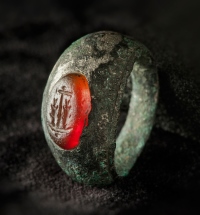
The archaeologists, assisted by volunteer diggers from AASDN have discovered a bath house with seven-foot high walls, which were once covered with brightly covered painted designs, and the original floor, doorways and window openings.
An inscribed altar dedicated to the Roman Goddess, Fortune the Home-bringer, has also been unearthed.
Dr David Mason, principal archaeologist, Durham County Council, said: “These findings are hugely significant as they are virtually in-tact and present a graphic illustration of life under the
Roman Empire. They are so stunning and spectacular that we can claim we have our very own ‘Pompeii of the north’ right on our doorstep.”
The excavation project, now in its sixth year, is a joint venture between archaeologists at Durham County Council, Durham University, the Architectural and Archaeological
Society of Durham and Northumberland land and several American universities.
Project coordinator, Dr David Petts, lecturer in archaeology at Durham University, said: “Our excavations have uncovered parts of one of the best preserved Roman buildings in Britain.
The building itself and the wonderful array of artefacts we have recovered from Binchester such as this jet pin with a polyhedral head give us an unparalleled opportunity to better understand life on the northern frontier in the
Roman period.
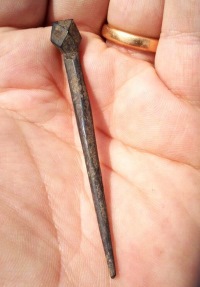
“For example, the altar is a reminder that bath houses were about more than keeping clean and exercising and were actually social centres – a bit like our modern day leisure centres.
“The most unique feature of these remains is the sheer scale of their preservation. It is possible to walk through a series of Roman rooms with walls all above head height; this is pretty
exceptional for Roman Britain.”
The altar has been inscribed by a retired trooper who served with a unit of the Spanish cavalry based at Binchester.
The trooper described his rank as “architectus” and this is the only example from the whole of the Roman Empire, outside of Rome itself, which shows that architects were on the staff of
auxiliary cavalry units and not just the legions of the Emperor’s personal protection unit, the Praetorian Guard.
About Binchester Fort
The Roman fort at Binchester lies above the River Wear just outside the town of Bishop Auckland in County Durham. Known to the Romans as Vinovia, it commanded the main road that ran from the
legionary headquarters at York northwards to Hadrian’s Wall. It formed a key element of the complex frontier system that lay both sides of the Wall that marked the northern-most
edge of the Roman Empire for nearly four hundred years. The fort itself was built to house a cavalry regiment in the early years of Roman control in Northern England. It housed troops
from across the Empire, including Spain and Germany. It was not just a military site, a thriving civilian settlement (vicus) grew up at its gates.
Unless stated all images © University of Durham.
 Binchester Trench 1, July 2014
Binchester Trench 1, July 2014
(click on the image for the full sized version) Image © Tony Metcalfe. See more of Tony's Binchester images on Twitter @TonyMetcalfe4
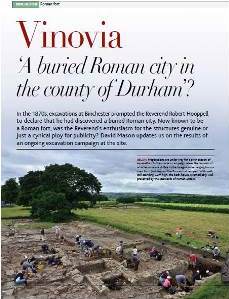
|
|
Vinovia
'A buried Roman city in the County of Durham?'
In the 1870s, excavations at Binchester prompted the Reverend Robert Hooppell
to declare that he had discovered a buried Roman city. Now known to be
a Roman fort, was the Reverend’s enthusiasm for the structures genuine or
just a cynical ploy for publicity? David Mason updates
Current Archaeology magazine on the results of
an ongoing excavation campaign at the site.
Click on the image to download the Current Archaeology article (CA 291).
|
The 2014 community excavation at Binchester will take place from Tuesday 10th June to Friday 25th July (excluding weekends).
There are places for volunteers on this seasons excavations so if you would like to take part please contact David Mason by telephone on 03000 267012 or email:
david.mason@durham.gov.uk for further information and an application form.
Binchester Roman Fort, the Class of 2013 (click on the image for the full sized version)
Image courtesy of Michael Boyd

![The Architectural and Archaeological Society of Durham and Northumberland]() |
Binchester Roman Fort
Season Five - 2013
The season this year is about halfway through and Society members are now fully engaged in the excavation alongside students from American universities. Things have moved on apace in the first
few weeks. In Trench 1 the existence of an earlier outer wall to the barrack building has been confirmed giving the building an original width of about 11 metres, closer to the average for a
building of this type. This was demolished in a late phase and the building’s width reduced to about 7 metres. The substantial drain along the edge of the intervallum road has now been revealed
for the entirety of its course within the trench. Excavation immediately north of the angle-tower has revealed a small masonry chamber beside it with a doorway in its north wall.
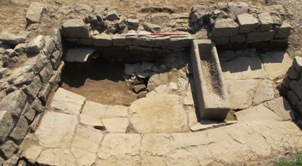
The interior has a neatly paved floor lying on the middle of which were two stone troughs one its original position. A drain passing beneath the west wall of the building was overlain by
fragments of a large flat stone with a keyhole-shaped aperture. Clearly this chamber was a latrine, presumably one of many distributed around the fort perimeter.
A definite edge has finally been found for the large pit cut into the intervallum road in front of the angle-tower. Removal of the rest of the fill will provide a useful glimpse of the build-up
of layers beneath the road surface currently exposed.
In Trench 2 work has concentrated on the high quality structures at the south end thought to be elements of the regimental bath-building. Beneath the layer of massive paving slabs
removed last year was another layer of paving composed of smaller blocks. Both layers may be contemporary with or earlier than a crudely constructed rectangular building erected on the area
immediately in front of the bath-building and partly overlying Dere Street. With foundations built of blocks robbed from the frontages of the latest buildings facing out onto Dere Street, as well as stones from the roadside drain, this building exhibits evidence of at least two, if not three, distinct phases. Its date is as yet not precisely determined but it is clearly as late as, and possibly much later than, the infilling of the neighbouring chambers in the bath-building with soil deposits containing vast amounts of animal bone.
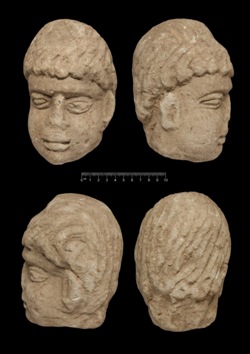
Removal of the fill in the larger of the two chambers has revealed a blocked-up doorway in its north wall as well as a section of masonry on the east side which may represent the
limits of the chamber on this side or possibly some internal feature. This fill also produced the object that has generated much media interest in the last week namely the small stone
head seemingly representing a local Romano-Celtic deity. Carved in a style not unlike that of the head belonging to the life-size statue of Antenociticus found in his temple at Benwell
this may represent a god local to Vinovia. Perhaps the rest of the statue, and more importantly an inscribed base, may come out of the remaining fill!
If you want more information contact David Mason, by telephone on 03000 267012 or email: david.mason@durham.gov.uk
To access the interim report for season four and to find out which specific research aims the field work has addressed so far, please visit: Vinovia: Durham-Stanford Research Project
|
Binchester - Overveiw
Following on from the
Time Team investigation at Binchester Roman Fort in 2007, a major research project was initiated, concentrating initially on an area in the interior of the fort,
the south east gateway and an area in the civil settlement. The Society was involved from the outset, and members have taken part in the community excavation every summer from 2009, and have also
participated in post excavation finds processing. The progress of the project may be followed on
The Binchester Blog
Binchester Roman Dig is a joint venture involving Durham County Council, Archaeological Services University of Durham (ASUD), the Department of Classics of Stanford University, and the Architectural and Archaeological Society of Durham and Northumberland.
To view more images from Binchester Roman Fort visit our
Gallery page.
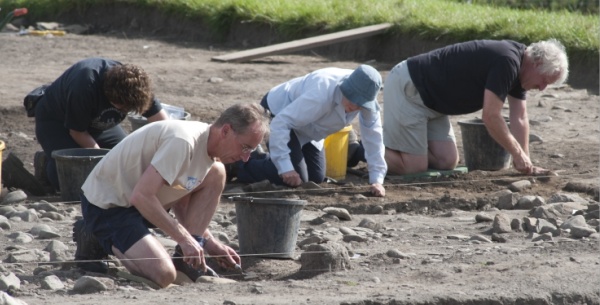
Remember to follow us on Twitter for news of new additions to the website!


